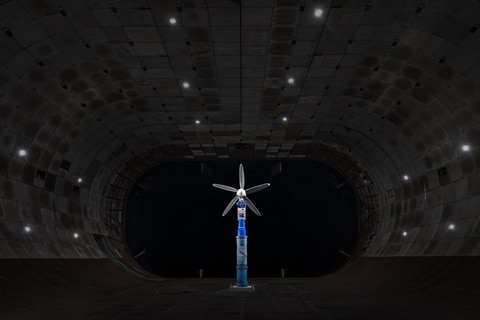Joby Aviation, a company developing all-electric aircraft for commercial passenger service, announced recently it is beginning testing at the National Full-Scale Aerodynamic Complex (NFAC), the world’s largest wind tunnel facility, at NASA’s Ames Research Center in California’s Silicon Valley.
The NFAC, managed by the U.S. Air Force’s Arnold Engineering Development Complex, contains the two largest operational wind tunnels in the world. Data from propeller testing in the NFAC — widely considered to be the gold standard for aircraft aerodynamics and performance — was instrumental in the development of a range of iconic vehicles, including the space shuttle, the V-22 Osprey, the F-35 Joint Strike Fighter, and a number of next-generation helicopters.
Joby is believed to be the first electric vertical take-off and landing (eVTOL) company to test its propeller in the NFAC’s 40-by-80 foot wind tunnel.
“Testing is a critical part of our aircraft program and the opportunity to gather data on the performance of our propellers in one of the world’s largest wind tunnels is an exciting step toward commercialization,” said JoeBen Bevirt, Founder and CEO of Joby.
“This facility helped introduce historic aircraft to the world, and now it’s doing the same for the next generation of sustainable aviation,” he added.
Lt Col Tom Meagher, Lead for AFWERX Prime programs, commented: “A cornerstone of the AFWERX Agility Prime program is fostering interagency partnerships and collaboration to progress the advanced air mobility segment. The NFAC testing is a perfect example of utilizing unique government test resources and infrastructure critical to enabling industry progression.”
The test campaign will cover all tilt angles and speeds through the expected flight envelope, providing Joby with consistent and high-fidelity data on the performance, loads, and acoustics of its propeller systems in support of its certification program with the Federal Aviation Administration (FAA).
Working in partnership with the U.S. Air Force and NASA, Joby is installing a production-intent electric propulsion unit and propeller assembly in the wind tunnel mounted to a six-degree-of-freedom force and moment balance to capture performance data. The blades are instrumented to measure the loads experienced while rotating, and a representative wing section of the Joby aircraft allows careful analysis of aerodynamic interference effects.
The NFAC propeller test campaign is expected to produce data of unparalleled quality – exceeding what is captured during normal flight testing – due to superior instrumentation and precise control of variables. The full test campaign is expected to take several months to complete.
Joby and NASA previously partnered on a variety of projects exploring electric aircraft technology, including the design of the agency’s all-electric X-57 Maxwell prototype. The agency also completed a two-week acoustic testing program with Joby in 2022 as part of NASA’s Advanced Air Mobility National Campaign.
The company says it is targeting the year 2025 to begin commercial aerial ridesharing service in the United States.
